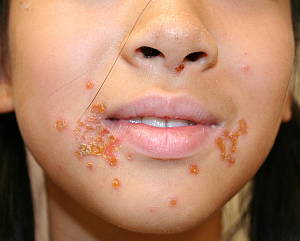Impetigo is a skin infection commonly caused by one of two bacteria – Streptococcus pyogenes or Staphylococcus aureus. This infection affects the epidermis, which is the outer layer of the skin. Impetigo is colloquially known as school sores and is a highly contagious infection. Any part of the skin can be affected by impetigo. However, the areas of skin around the mouth and nose are often affected first. In some people, S. pyogenes and S. aureus are part of the normal flora (microorganisms that live harmlessly on our skin) of the nose and throat. However, if the skin is broken by a cut, scratch or even a condition like eczema, the organisms can then cause an infection.
Bullous vs. Non-Bullous Impetigo
Impetigo is broadly classified into two forms: bullous and non-bullous. Non-bullous impetigo is the more common of the two forms. It is also known as impetigo contagiosa. As the name implies, this is more contagious than bullous impetigo. Non-bullous impetigo can be caused by either S. aureus or S. pyogenes; and in some cases both. In this form of impetigo, a number of small blisters form and quickly rupture, causing a yellow crust to form over the top.
Bullous impetigo is less common and less contagious. Nearly all cases are the result of a S. aureus infection. This type of impetigo most commonly affects newborns and infants. In the bullous form, larger blisters develop which are often filled with a yellow fluid. After about 3 days, the blisters burst and a light brown coloured crust forms over the top.
Signs and Symptoms
After being in contact with someone with impetigo, it can take up to 3 days for signs and symptoms to occur if S. pyogenes is causing the infection, and up to 10 days if S. aureus is the causative organism. The lesions which appear on the skin differ depending on the type of impetigo. The characteristic patterns of these are described above. Often before the lesions form, the skin is itchy and red. If the infection is severe, there may also be an accompanying fever, enlarged lymph nodes or ‘swollen glands’ and feelings of sickness. The latter list of symptoms more commonly occur in bullous impetigo, but can also occur in severe cases of non-bullous impetigo. The skin surrounding both types of lesions will be incredibly itchy, but it is very important to resist the urge to scratch the skin, as this can spread the infection to other parts of the body.
Risk Factors
Several factors can increase the risk of developing impetigo, including:
- Age: young children, especially children in day-care, pre-school and primary schools, are most likely to develop impetigo. However, it is possible for anyone at any age to be affected by impetigo
- Season: impetigo is more common in the warmer summer months
- Crowding: Impetigo can be spread easily at crowded day care centres. Over-crowded homes are a significant risk factor for the spread of impetigo in some remote Australian communities
- Diabetes and other conditions that affect the ability of the immune system to protect us from infection
- Contact sports – sports such as rugby which involve physical contact can also promote the spread of impetigo
- Cuts, abrasions, chickenpox, eczema and other skin conditions lead to breaks in the surface of the skin that can introduce S. aureus and S. pyogenes which can then cause infection
- Poor hygiene
- Sharing towels and clothes with an infected individual
Transmission
 Impetigo, especially the non-bullous form, is highly contagious and can easily be spread from one person to another and from one location on the body to another. Scratching at the blisters, and then touching another part of your body can help to spread impetigo to another location. Impetigo is spread easily from one person to another; both through direct contact and through sharing items such as towels and clothes. In order to limit the spread of impetigo to others, it is important to try not to touch the sores and to wash or sanitise your hands thoroughly after doing so. Taking a few days off school or day care is also necessary to stop the spread to other children, and upon return make sure to cover the sores with a water-proof dressing. Avoid sharing towels and clothing with the affected person, as the germs can be spread via these items. If you are looking after someone with impetigo, make sure you also wash or sanitise your hands after contact or performing wound care.
Impetigo, especially the non-bullous form, is highly contagious and can easily be spread from one person to another and from one location on the body to another. Scratching at the blisters, and then touching another part of your body can help to spread impetigo to another location. Impetigo is spread easily from one person to another; both through direct contact and through sharing items such as towels and clothes. In order to limit the spread of impetigo to others, it is important to try not to touch the sores and to wash or sanitise your hands thoroughly after doing so. Taking a few days off school or day care is also necessary to stop the spread to other children, and upon return make sure to cover the sores with a water-proof dressing. Avoid sharing towels and clothing with the affected person, as the germs can be spread via these items. If you are looking after someone with impetigo, make sure you also wash or sanitise your hands after contact or performing wound care.
How the Bacteria Cause Infection
The bacteria that cause impetigo have special mechanisms that allow them to cause an infection; these are called virulence factors. S. pyogenes is classified as a Group A Streptococcus, and can cause a range of infections in the body, including a sore throat. S. pyogenes has three main virulence factors which help it to cause infection:
- M protein: This is a protein which is found on the surface of S. pyogenes. M proteins help the bacteria avoid being destroyed by the immune system. The immune system is helped by another system of proteins, called the complement system. One of the roles of the complement proteins is to “tag” bacteria, viruses and other invaders to be destroyed by the immune system. Attachment of a complement protein to the bacterium will tell the immune system’s phagocyte cells to destroy it. The M protein stops the complement proteins binding to parts of the bacterial cell, and helps S. pyogenes to avoid being destroyed by the immune system.
- Streptokinase- streptokinase is an enzyme possessed by S. pyogenes. This helps the organisms to spread between tissues because streptokinase breaks down some of the structural proteins holding tissues together, allowing the bacteria to spread through the body.
- Hyaluronidase – this is another enzyme that facilitates the spread of S. pyogenes by breaking down connective tissues, allowing the organisms to migrate to other regions.
Treatment
The treatment of impetigo depends on the severity of the infection and the risk of spread to others. If there are only a handful of small lesions, a solution of soap and water can be dabbed over the crusts to soften them. This should be performed every 6 to 8 hours. It is important to be gentle when doing this – the aim is not to rub off the crusts. Rubbing and scratching the crusts off can lead to scarring, so this needs to be performed gently. If you are caring for your child’s impetigo, it is important to wash your hands before and after sponging the crusts to prevent spreading the infection and to avoid contaminating the existing lesions with more bacteria. Wearing disposable gloves is also a good idea. Your doctor may also recommend a topical antibiotic cream which can be rubbed into the affected areas.
If there are lots lesions, or the infection does not heal, antibiotics are the recommended course of treatment. A swab may be taken from the lesion to work out which bacteria are causing the infection; this will help to guide the choice of the antibiotic prescribed. If the infection is caused by S. pyogenes, penicillin is the recommended antibiotic. If there is a penicillin allergy, a different antibiotic called roxythromycin may be prescribed. If the impetigo is being caused by S. aureus, then the preferred antibiotic is dicloxacillin. As with all infections, if prescribed antibiotics, you need to finish the entire course of medication, even if you notice an improvement in a few days to ensure that all of the bacteria have been killed and to minimise the development of antibiotic resistance.
Possible Complications
There are a few possible complications that can occur following impetigo or an infection with group A streptococcus. Some possible complications include:
- Scarring: picking at the sores or scrubbing off the crusts can lead to scarring of the affected area. To limit the possibility of this complication, try to avoid scratching, picking and rubbing at the affected area
- Cellulitis: cellulitis is an infection which affects a deeper layer of the skin (the subcutaneous tissue). The bacteria involved in impetigo can affect the deeper layer of skin. This infection is serious and needs to be treated rapidly with intravenous antibiotics
- Glomerulonephritis: glomerulonephritis is a rare complication which affects the kidneys. It only occurs with specific strains of the S. pyogenes bacterium. It causes inflammation of the kidneys as a result of a reaction to the antibodies formed to S. pyogenes.
Impetigo can be difficult to effectively control. Dermatologists are highly experienced in managing this condition. If you have any questions or concerns about impetigo, contact our clinic for an appointment. Contact us today.



